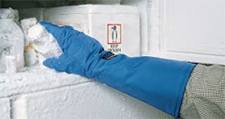Page content

Working safely
Gases can be made liquid or solid by increasing pressure or by strong cooling. Gases that have become liquid (or solid, as with carbon dioxide) at very low temperatures (below 150°C) are called cryogenic substances. In addition to their (hazardous) substance properties, cryogenic substances have additional risks related to their low temperatures. These risks can be divided into:
- Effects of the low temperature on the environment they come into contact with, such as embrittlement of materials and freezing of limbs.
- Effects of pressure formation due to rapid evaporation, such as explosion hazard of ampoules.
Which substances
The most commonly used cryogenic substances in hospitals are:
- argon
- helium
- nitrogen
- oxygen
Reducing risks

If you are working with cryogenic substances, use appropriate personal protective equipment and equipment. Think of:
- Assistive devices, such as:
- Pliers
- Tweezers
- Dippers (jugs with a long handle)
- Portable oxygen or carbonic acid detection equipment (if required)
- Personal protective equipment, such as:
- Cryogenic gloves
- Face shield or goggles
- Apron
- Closed shoes
The following rules apply to working with personal protective equipment:
- Wear clean, dry clothing that is made from natural materials.
- Preferably cover the arms and legs completely and wear closed footwear.
- Use a work apron as protection for clothes.
- Use special insulating gloves when there is a chance of drops of the cold gas getting on the hands. The gloves should be made of materials that do not become brittle at low temperatures.
- Also wear gloves when direct contact with cold parts of the installation is possible.
- Use good eye protection, preferably total face protection. The eyes are very vulnerable.
- Make sure that the protective equipment can be removed quickly if the very cold gas has come into contact with it. They should therefore not be too tight under any circumstances.
Spaces
The following facilities are available in rooms with cryogenic substances:
- a warning sign at the entrance door
- Sufficient ventilation with floor extraction
- oxygen detection and alarms
Barrels

The following safety rules apply to vessels with cryogenic substances:
- Be aware of possible pressure formation in vessels and parts of the installation. Make sure the pressure relief valves are functioning. Portable drums should therefore not be closed with a lid without overpressure protection.
- Place storage vessels in separate, central rooms as much as possible, and preferably connect them to an automatic filling system.
- To avoid physical strain, work with a hoist to remove heavy racks of sample from large storage vessels.
- Transport of transport vessels with a transport trolley. Never leave it unattended.
- Do not transport open barrels in an elevator where people are present.
- Have drums and filling systems periodically checked or inspected and maintained by the supplier or a maintenance service.
- Use only stainless steel or aluminum open dewar vessels. Glass open dewar vessels are not suitable for cryogenic liquids due to the risk of implosion.
- For storage of small quantities of cryogenic substances, only use specially developed vessels. So never use a regular thermos!
- Provide stickers on the barrels with the following information:
- Risks
- Danger signs
- Procedure in the event of emergencies
Supplier
Consult the safety information provided by the supplier about the cryogenic substances or about the equipment involved.
Good practice: calculate the amount of liquid nitrogen in a room
This is a calculation tool that can be used to get some 'feel' for the amount of liquid nitrogen stored in a room. This is in relation to the ventilation rate (in h-1) and the size of the room (in m3). The colors green, orange and red indicate whether there is a safe, less safe or dangerous situation. A similar calculation is available for dry ice (solid CO2).
Cryospace calculation (An xlsm file is downloaded to your computer, click on the <open> tab in the sheet. Ignore the notification about the macros.)
